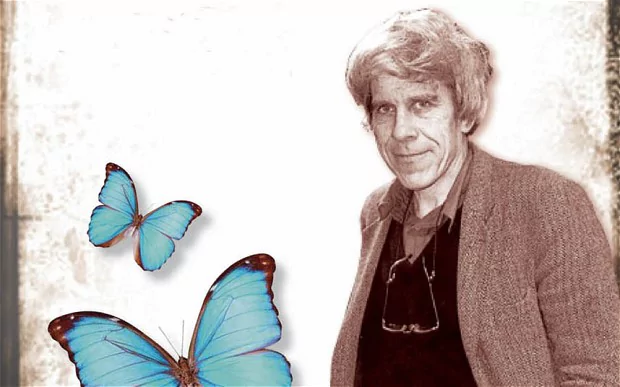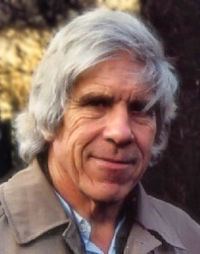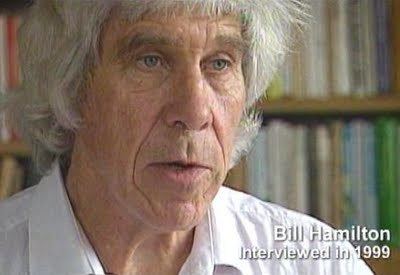Nationality British Awards International Prize Parents A. M. Hamilton | Name W. Hamilton | |
 | ||
Alma mater University College LondonLondon School of EconomicsSt. John's College, Cambridge Academic advisors John HajnalCedric Smith Doctoral students Laurence HurstOlivia Judson Books Narrow Roads of Gene Lan, Charles Sangster and His, Charles Sangster, Narrow Roads of Gene Lan, Old North Esk Revised Similar People John Maynard Smith, Robert Trivers, Richard Dawkins, George C Williams, Ronald Fisher | ||
W. D. Hamilton | Wikipedia audio article
William Donald "Bill" Hamilton, FRS (1 August 1936 – 7 March 2000) was an English evolutionary biologist, widely recognised as one of the most significant evolutionary theorists of the 20th century.
Contents
- W D Hamilton Wikipedia audio article
- Early life
- Hamiltons rule
- Spiteful behaviour
- Extraordinary sex ratios
- Chasing the Red Queen
- Return to Britain
- Social evolution
- Expedition to the Congo
- Death
- Awards
- Biographies
- Collected papers
- Significant papers
- References

Hamilton became famous through his theoretical work expounding a rigorous genetic basis for the existence of altruism, an insight that was a key part of the development of a gene-centric view of evolution. He is considered one of the forerunners of sociobiology, as popularized by E. O. Wilson. Hamilton also published important work on sex ratios and the evolution of sex. From 1984 to his death in 2000, he was a Royal Society Research Professor at Oxford University.

Early life
Hamilton was born in 1936 in Cairo, Egypt, the second of seven children. His parents were from New Zealand; his father A. M. Hamilton an engineer, and his mother B. M. Hamilton a medical doctor. The Hamilton family settled in Kent. During the Second World War, the young Hamilton was evacuated to Edinburgh. He had an interest in natural history from an early age and would spend his spare time collecting butterflies, and other insects. In 1946 he discovered E. B. Ford's New Naturalist book Butterflies, which introduced him to the principles of evolution by natural selection, genetics, and population genetics.
He was educated at Tonbridge School, where he was in Smythe House. As a twelve-year-old he was seriously injured while playing with explosives his father had. These were left over from his father making hand grenades for the Home Guard during World War II; he had to have a thoracotomy and fingers on his right hand had to be amputated in King's College Hospital to save his life, and he was left with scarring and needed six months to recover.
Before going up to the University of Cambridge he travelled in France and completed two years of national service. As an undergraduate at St. John's College, he was uninspired by the "many biologists [who] hardly seemed to believe in evolution". He was intrigued by Ronald Fisher's book The Genetical Theory of Natural Selection; but Fisher lacked standing at Cambridge, being viewed as only a statistician. Hamilton was excited by Fisher's chapters on eugenics. In earlier chapters, Fisher provided a mathematical basis for the genetics of evolution and Hamilton later blamed Fisher's book for his getting only a 2:1 degree.
Hamilton's rule
Hamilton enrolled in an MSc course in demography at the London School of Economics (LSE), under Norman Carrier, who helped secure various grants for his studies. Later, when his work became more mathematical and genetical, he had his supervision transferred to John Hajnal of the LSE and Cedric Smith of University College London (UCL).
Both Fisher and J. B. S. Haldane had seen a problem in how organisms could increase the fitness of their own genes by aiding their close relatives, but not recognised its significance or properly formulated it. Hamilton worked through several examples, and eventually realised that the number that kept falling out of his calculations was Sewall Wright's coefficient of relationship. This became Hamilton's rule: in each behaviour-evoking situation, the individual assesses his neighbour's fitness against his own according to the coefficients of relationship appropriate to the situation. Algebraically, the rule posits that a costly action should be performed if:
Where C is the cost in fitness to the actor, r the genetic relatedness between the actor and the recipient, and B is the fitness benefit to the recipient. Fitness costs and benefits are measured in fecundity. r is a number between 0 and 1. His two 1964 papers entitled The Genetical Evolution of Social Behavior are now widely referenced.
The proof and discussion of its consequences, however, involved detailed mathematics, and two reviewers passed over the paper. The third, John Maynard Smith, did not completely understand it either, but recognised its significance. Having his work passed over later led to friction between Hamilton and Maynard Smith, as Hamilton thought Smith had held his work back to claim credit for the idea (during the review period Maynard Smith published a paper that referred briefly to similar ideas). The Hamilton paper was printed in the Journal of Theoretical Biology and, when first published, was largely ignored. Recognition of its significance gradually increased to the point that it is now routinely cited in biology books.
Much of the discussion relates to the evolution of eusociality in insects of the order Hymenoptera (ants, bees and wasps) based on their unusual haplodiploid sex-determination system. This system means that females are more closely related to their sisters than to their own (potential) offspring. Thus, Hamilton reasoned, a "costly action" would be better spent in helping to raise their sisters, rather than reproducing themselves.
Spiteful behaviour
In his 1970 paper Selfish and Spiteful Behaviour in an Evolutionary Model Hamilton considers the question of whether harm inflicted upon an organism must inevitably be a byproduct of adaptations for survival. What of possible cases where an organism is deliberately harming others without apparent benefit to the self? Such behaviour Hamilton calls spiteful. It can be explained as the increase in the chance of an organism's genetic alleles to be passed to the next generations by harming those that are less closely related than relationship by chance.
Spite, however, is unlikely ever to be elaborated into any complex forms of adaptation. Targets of aggression are likely to act in revenge, and the majority of pairs of individuals (assuming a panmictic species) exhibit a roughly average level of genetic relatedness, making the selection of targets of spite problematic.
Extraordinary sex ratios
Between 1964 and 1977 Hamilton was a lecturer at Imperial College London. Whilst there he published a paper in Science on "extraordinary sex ratios". Fisher (1930) had proposed a model as to why "ordinary" sex ratios were nearly always 1:1 (but see Edwards 1998), and likewise extraordinary sex ratios, particularly in wasps, needed explanations. Hamilton had been introduced to the idea and formulated its solution in 1960 when he had been assigned to help Fisher's pupil A.W.F. Edwards test the Fisherian sex ratio hypothesis. Hamilton combined his extensive knowledge of natural history with deep insight into the problem, opening up a whole new area of research.
The paper was also notable for introducing the concept of the "unbeatable strategy", which John Maynard Smith and George R. Price were to develop into the evolutionarily stable strategy (ESS), a concept in game theory not limited to evolutionary biology. Price had originally come to Hamilton after deriving the Price equation, and thus rederiving Hamilton's rule. Maynard Smith later peer reviewed one of Price's papers, and drew inspiration from it. The paper was not published but Maynard Smith offered to make Price a co-author of his ESS paper, which helped to improve relations between the men. Price committed suicide in 1975, and Hamilton and Maynard Smith were among the few present at the funeral.
Hamilton was regarded as a poor lecturer. This shortcoming would not affect the popularity of his work, however, as it was popularised by Richard Dawkins in Dawkins' 1976 book The Selfish Gene.
In 1966 he married Christine Friess and they were to have three daughters, Helen, Ruth and Rowena. 26 years later they amicably separated.
Hamilton was a visiting professor at Harvard University and later spent nine months with the Royal Society's and the Royal Geographical Society's Xavantina-Cachimbo Expedition as a visiting professor at the University of São Paulo.
From 1978 Hamilton was Professor of Evolutionary Biology at the University of Michigan. Simultaneously, he was elected a Foreign Honorary Member of American Academy of Arts and Sciences. His arrival sparked protests and sit-ins from students who did not like his association with sociobiology. There he worked with the political scientist Robert Axelrod on the prisoner's dilemma, and was a member of the BACH group with original members Arthur Burks, Robert Axelrod, Michael Cohen, and John Holland.
Chasing the Red Queen
Hamilton was an early proponent of the Red Queen theory of the evolution of sex, first proposed by Leigh Van Valen. This was named for a character in Lewis Carroll's Through the Looking-Glass, who is continuously running but never actually travels any distance:
"Well, in our country," said Alice, still panting a little, "you'd generally get to somewhere else—if you ran very fast for a long time, as we've been doing.""A slow sort of country!" said the Queen. "Now, here, you see, it takes all the running you can do, to keep in the same place. If you want to get somewhere else, you must run at least twice as fast as that!" (Carroll, pp. 46)This theory hypothesizes that sex evolved because new and unfamiliar combinations of genes could be presented to parasites, preventing the parasite from preying on that organism: species with sex were able to continuously "run away" from their parasites. Likewise, parasites were able to evolve mechanisms to get around the organism's new set of genes, thus perpetuating an endless race.
Return to Britain
In 1980 he was elected a Fellow of the Royal Society, and in 1984 he was invited by Richard Southwood to be the Royal Society Research Professor in the Department of Zoology at Oxford, and a Fellow of New College, where he remained until his death.
From 1994 Hamilton found companionship with Maria Luisa Bozzi, an Italian science journalist and author.
His collected papers, entitled Narrow Roads of Gene Land, began to be published in 1996. The first volume was entitled Evolution of Social Behaviour.
Social evolution
The field of social evolution, of which Hamilton's rule has central importance, is broadly defined as being the study of the evolution of social behaviours, i.e. those that impact on the fitness of individuals other than the actor. Social behaviours can be categorized according to the fitness consequences they entail for the actor and recipient. A behaviour that increases the direct fitness of the actor is mutually beneficial if the recipient also benefits, and selfish if the recipient suffers a loss. A behaviour that reduces the fitness of the actor is altruistic if the recipient benefits, and spiteful if the recipient suffers a loss. This classification was first proposed by Hamilton in 1964.
Hamilton also proposed the coevolution theory of autumn leaf color as an example of evolutionary signalling theory.
Expedition to the Congo
During the 1990s Hamilton became increasingly interested in the controversial argument that the origin of HIV lay in oral polio vaccines trials conducted by Hilary Koprowski in Africa during the 1950s. Letters by Hamilton on the topic to the major peer-reviewed journals were rejected. To look for indirect evidence of the OPV hypothesis by assessing natural levels of simian immunodeficiency virus, in primates, in early 2000 he and two others ventured on a field trip to the war-torn Democratic Republic of the Congo.
Death
He returned to London from Africa on 29 January 2000. He was admitted to University College Hospital, London, on 30 January 2000. He was transferred to Middlesex Hospital on 5 February 2000 and died there on 7 March 2000. An inquest was held on 10 May 2000 at Westminster Coroner's Court to inquire into rumours about the cause of his death. The coroner concluded that his death was due to "Multi-organ failure due to upper gastrointestinal haemorrhage due to a duodenal diverticulum and arterial bleed through a mucosal ulcer". Following reports attributing his death to complications arising from malaria, the BBC Editorial Complaints Unit's investigation established that he had contracted malaria during his final African expedition. However, the pathologist had suggested the possibility that the ulceration and consequent haemorrhage had resulted from a pill (which might have been taken because of malarial symptoms) lodging in the diverticulum; but, even if this suggestion were correct, the link between malaria and the observed causes of death would be entirely indirect.
A secular memorial service (he was an agnostic) was held at the Chapel of New College, Oxford on 1 July 2000, organised by Richard Dawkins. He was buried near Wytham Woods. He, however, had written an essay on My intended burial and why in which he wrote:
The second volume of his collected papers, Evolution of Sex, was published in 2002, and the third and final volume, Last Words, in 2005.
Awards
Biographies
Collected papers
Hamilton started to publish his collected papers starting in 1996, along the lines of Fisher's collected papers, with short essays giving each paper context. He died after the preparation of the second volume, so the essays for the third volume come from his coauthors.
